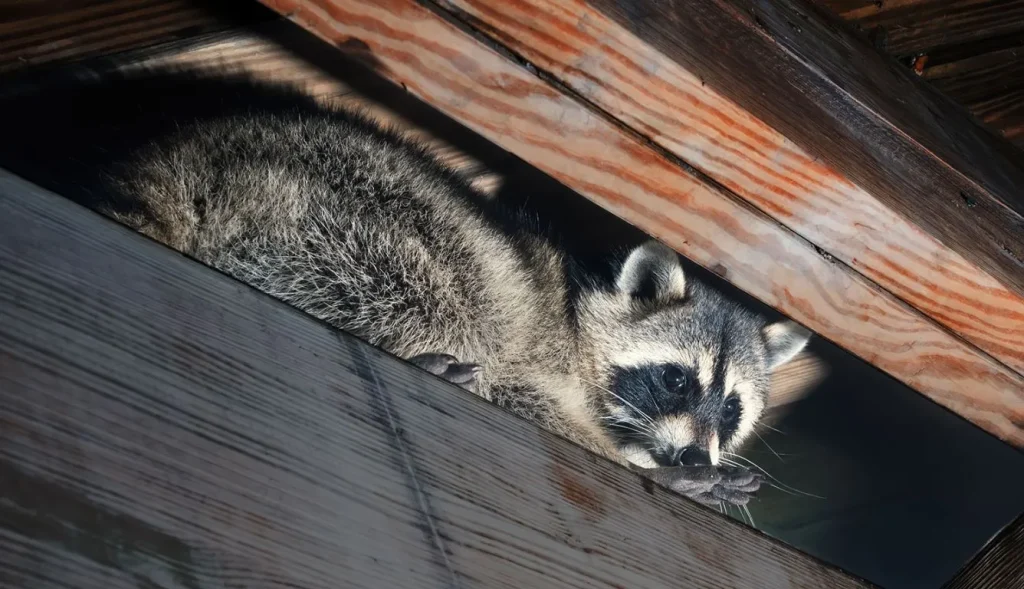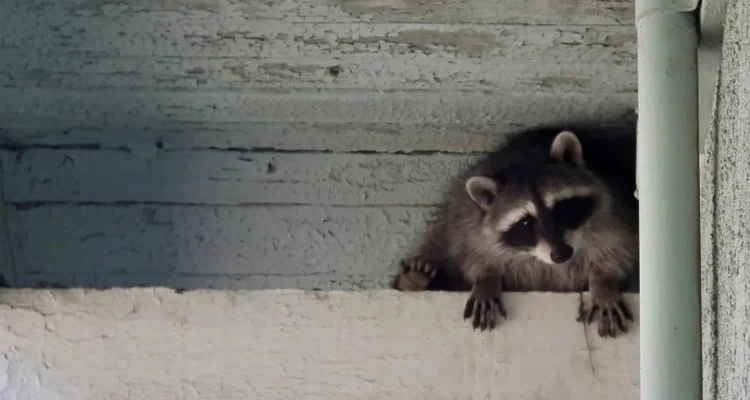Introduction
Got a raccoon in your attic? You’re not alone. These clever critters often find their way into homes seeking shelter and food. But having a raccoon up there isn’t just a nuisance—it can be downright dangerous. So, let’s dive into why it’s important to tackle this issue and how you can safely and effectively evict your unwelcome guest.

Signs of a Raccoon Infestation
Before you jump to conclusions, you need to be sure it’s raccoons you’re dealing with. Here are some telltale signs:
Noises in the Attic
Raccoons are nocturnal, so if you’re hearing strange noises like scratching, thumping, or chittering at night, it’s a strong indicator.
Visible Damage
Check for damage around vents, eaves, and shingles. Raccoons are known to rip and tear at these areas to gain entry.
Foul Odors
A raccoon’s den isn’t exactly a five-star hotel. If you notice a strong, unpleasant smell, it could be due to raccoon urine or droppings.
Tracks and Droppings
Raccoon tracks are quite distinctive, resembling tiny handprints. Their droppings are similar to those of a small dog but may contain undigested food.
Why Raccoons Choose Attics
Understanding why raccoons prefer attics can help in preventing future invasions.
Shelter and Safety
Attics provide a safe, warm, and dry environment, perfect for nesting and raising their young.
Access to Food Sources
Your home might offer easy access to food, whether it’s from garbage cans, pet food left outside, or even a bird feeder.
Ideal Nesting Sites
Attics offer a quiet and undisturbed area, away from predators and the elements, making them ideal for raccoons to set up camp.
Dangers of Having Raccoons in Your Attic
It’s not just about the noise and mess—raccoons can pose serious risks.
Health Risks
Raccoons can carry diseases like rabies and leptospirosis. Their droppings can also harbor parasites and bacteria harmful to humans.
Structural Damage
Raccoons are notorious for causing significant structural damage. They can tear up insulation, chew through wiring, and damage wooden beams.
Electrical Hazards
Chewing on electrical wires can lead to short circuits, increasing the risk of a fire.
Initial Steps to Take
If you suspect raccoons in your attic, here’s what to do first:
Confirming the Presence of Raccoons
Use a flashlight to inspect your attic. Look for droppings, nesting materials, or the raccoons themselves. If you’re unsure, setting up a motion-activated camera can provide confirmation.
Avoiding Direct Confrontation
Raccoons can be aggressive if cornered, especially mothers with their young. Avoid direct contact and keep pets and children away from the area.
Preparing for Removal
Before you start the eviction process, get prepared:
Gathering Necessary Tools and Equipment
You’ll need heavy-duty gloves, a flashlight, a face mask, and possibly a humane trap.
Ensuring Safety Measures
Wear protective clothing and make sure you’re up to date on your tetanus shot. It’s better to be safe than sorry!
Humane Removal Methods
Here are some humane ways to evict your raccoon tenant:
One-Way Exclusion Doors
These devices allow raccoons to leave the attic but not re-enter. Install them at the main entry point.
Live Trapping
Live traps can be effective but should be used with caution and in accordance with local laws. Bait the trap with something irresistible, like marshmallows or peanut butter.
Professional Wildlife Removal Services
If you’re not comfortable handling the situation yourself, hire a professional. They have the expertise and equipment to remove raccoons safely and humanely.
Preventing Re-entry
Once the raccoons are gone, you’ll want to make sure they don’t come back.
Sealing Entry Points
Thoroughly inspect your home and seal any potential entry points. Use materials like metal flashing, which raccoons can’t chew through.
Using Deterrents
Consider using raccoon repellents, such as ammonia-soaked rags or commercial raccoon repellents. Motion-activated lights or sprinklers can also be effective.
Regular Maintenance and Inspections
Regularly inspect your home for signs of entry or damage, especially after a storm or high winds.
Cleaning and Repairing the Attic
After removal, clean up the mess and repair any damage.
Safe Cleanup of Droppings and Nesting Materials
Wear protective gear and use disinfectants to clean the area thoroughly. Dispose of all materials in sealed bags.
Repairing Any Damage Caused by Raccoons
Repair insulation, wiring, and any structural damage. It’s important to restore your attic to prevent future infestations.
Long-term Prevention Strategies
Prevent future invasions with these strategies:
Maintaining a Clean Yard
Keep your yard free of debris and secure garbage cans with tight-fitting lids.
Removing Food Sources
Don’t leave pet food or bird seed outside. Raccoons are opportunistic feeders and will take advantage of any available food.
Regular Home Inspections
Conduct regular inspections to ensure your home remains raccoon-free. Pay special attention to the roof and eaves.
Dealing with Baby Raccoons
Special care is needed if there are baby raccoons involved.
Identifying If There Are Babies Present
Listen for high-pitched noises, which indicate the presence of babies. They’re usually born in early spring or late summer.
Special Considerations for Removing a Mother and Her Young
If you find babies, it’s best to wait until they’re old enough to leave with their mother. Alternatively, call a professional who can safely relocate the family.
Legal and Ethical Considerations
It’s crucial to understand the legal and ethical aspects of raccoon removal.
Understanding Local Wildlife Laws
Check your local wildlife regulations before attempting removal. Some areas have specific laws protecting raccoons.
Ethical Treatment of Animals
Always aim for humane removal methods. Avoid poisons or lethal traps, as they cause unnecessary suffering.
When to Call a Professional
Sometimes, professional help is the best option.
Signs You Need Expert Help
If the raccoons are aggressive, if you’re dealing with multiple animals, or if you’re unsure how to proceed, it’s time to call in the pros.
Choosing the Right Wildlife Removal Service
Look for licensed and insured professionals with good reviews. They should use humane removal methods and provide repair services.
DIY vs. Professional Removal
Deciding between DIY and professional help can be tricky.
Pros and Cons of Each Approach
DIY methods are cheaper but require time and effort. Professionals are more expensive but offer expertise and efficiency.
Cost Considerations
While professional services come at a cost, they can save you money in the long run by preventing further damage.
FAQs
How can I tell if there are raccoons in my attic?
Listen for noises at night, check for droppings and tracks, and look for damage around potential entry points.
Are raccoons dangerous to humans?
Yes, they can carry diseases and cause significant property damage.
What should I do if I find baby raccoons?
It’s best to call a professional who can safely relocate them with their mother.
How much does professional raccoon removal cost?
Costs vary but typically range from $150 to $500, depending on the complexity of the removal and repairs needed.
Can raccoons cause long-term damage to my home?
Yes, they can damage insulation, wiring, and structural components, leading to costly repairs.
Conclusion
Evicting raccoons from your attic requires patience and persistence. By following these steps, you can ensure a safe, humane, and effective removal process. Remember, prevention is key to keeping your home raccoon-free in the future.


Congratulation!